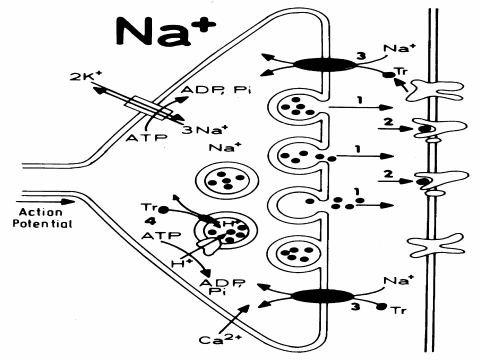 |
Starting with the
synapse at rest, synaptic vesicles loaded with neurotransmitter (·,
Tr) are concentrated in the axon terminal, and an action potential travels
down the nerve fiber to the axon terminal. Upon depolarization of the axon
terminal, calcium enters and triggers fusion of synaptic vesicles with the
synaptic membrane of the pre-synaptic cell, a process that involves specific
interactions between a number of proteins. At this point, the contents of
the synaptic vesicles (i.e., neurotransmitters) are released into the
synaptic cleft (1) where they diffuse to the post-synaptic cell membrane,
bind specifically to a receptor (2) and open a channel for sodium (with
depolarization of the post-synaptic cell) or chloride (with
hyperpolarization of the post-synaptic cell). In order to terminate the
signal, the neurotransmitter is transported back into the pre-synaptic cells
via neurotransmitter re-uptake proteins that are specific for different
neurotransmitters (3). Transport is usually sodium-coupled, but frequently,
translocation of other ions (K+ or Cl-) is also required for accumulation.
Once inside of the axon terminal, the neurotransmitters are actively
transported and re-packaged in synaptic vesicles (4). There is a so-called
vacuolar ATPase on the outer surface of the synaptic vesicle membrane that
utilizes ATP hydrolysis to pump protons into the synaptic vesicles, thereby
generating a ∆µH+
(interior positive and acid, as in ISO E. coli membrane vesicles). The
neurotransmitter is then actively transported into the synaptic vesicles by
means of specific antiporters in the synaptic vesicle membrane (i.e.,
protons move out of the synaptic vesicles down their electrochemical
gradient, and the energy released by this process is used to accumulate
neurotransmitter against a concentration gradient). The synaptic vesicles in
the pre-synaptic axon terminal are now reloaded and ready to release
neurotransmitter again. |
